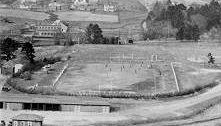
Auburn is a city in Lee County, Alabama, United States. It is the largest city in eastern Alabama, with a 2020 population of 76,143. It is a principal city of the Auburn-Opelika Metropolitan Area. The Auburn-Opelika, AL MSA with a population of 158,991, along with the Columbus, GA-AL MSA and Tuskegee, Alabama, comprises the greater Columbus-Auburn-Opelika, GA-AL CSA, a region home to 501,649 residents.
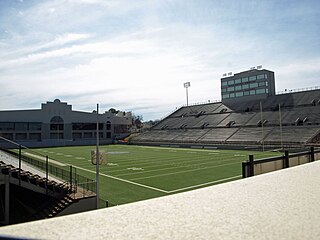
Cramton Bowl is a 25,000-seat stadium located in Montgomery, Alabama. Cramton Bowl opened in 1922 as a baseball stadium and has been home to Major League Baseball spring training and to minor league baseball. Today, however, its primary use is for American football.

Jordan-Hare Stadium is an American football stadium in Auburn, Alabama on the campus Auburn University. It primarily serves as the home venue of the Auburn Tigers football team. The stadium is named for Ralph "Shug" Jordan, who owns the most wins in school history, and Cliff Hare, a member of Auburn's first football team as well as Dean of the Auburn University School of Chemistry and President of the Southern Conference. On November 19, 2005, the playing field at the stadium was named in honor of former Auburn coach and athletic director Pat Dye. The venue is now known as Pat Dye Field at Jordan-Hare Stadium. The stadium reached its current seating capacity of 87,451 with the 2004 expansion and is the 10th largest stadium in the NCAA. For years, it has been a fixture on lists of best gameday atmospheres and most intimidating places to play.

William Wallace Wade was an American football player and coach of football, basketball, and baseball, and college athletics administrator. He served as the head football coach at the University of Alabama from 1923 to 1930 and at Duke University from 1931 to 1941 and again from 1946 to 1950, compiling a career college football record of 171–49–10. His tenure at Duke was interrupted by military service during World War II. Wade's Alabama Crimson Tide football teams of 1925, 1926, and 1930 have been recognized as national champions, while his 1938 Duke team had an unscored upon regular season, giving up its only points in the final minute of the 1939 Rose Bowl. Wade won a total of ten Southern Conference football titles, four with Alabama and six with the Duke Blue Devils. He coached in five Rose Bowls including the 1942 game, which was relocated from Pasadena, California to Durham, North Carolina after the attack on Pearl Harbor.

Auburn High School is a public high school in Auburn, Alabama. It is the only high school in the Auburn City School District. Auburn High offers technical, academic, and International Baccalaureate programs, as well as joint enrollment with Southern Union State Community College and Auburn University. Auburn High School is accredited by the Southern Association of Colleges and Schools.
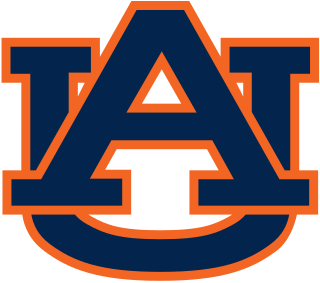
The Auburn Tigers football program represents Auburn University in the sport of American college football. Auburn competes in the Football Bowl Subdivision (FBS) of the National Collegiate Athletic Association (NCAA) and the Western Division of the Southeastern Conference (SEC).
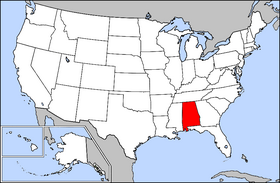
The Alabama High School Athletic Association (AHSAA), based in Montgomery, is the governing body for interscholastic athletics and activities programs for public schools in Alabama.

Michael Joseph "Iron Mike" Donahue was an American football player, coach of football, basketball, baseball, tennis, track, soccer, and golf, and a college athletics administrator. He served as the head football coach at Auburn University, at Louisiana State University (1923–1927), and at Spring Hill College (1934).
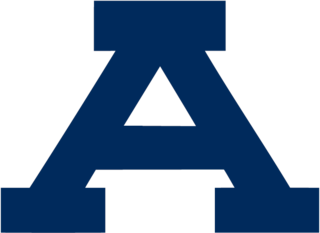
The 1918 Auburn Tigers football team represented Auburn University in the 1918 college football season. It was the Tigers' 27th season and they competed as a member of the Southern Intercollegiate Athletic Association (SIAA). The team was led by head coach Mike Donahue, in his 14th year, and played their home games at Drake Field in Auburn, Alabama. They finished with a record of two wins and five losses.

The 1920 Auburn Tigers football team represented Auburn University in the 1920 Southern Intercollegiate Athletic Association football season. It was the Tigers' 29th overall season and they competed as a member of the Southern Intercollegiate Athletic Association (SIAA). The team was led by head coach Mike Donahue, in his 16th year, and played their home games at Drake Field in Auburn, Alabama. They finished with a record of seven wins and two losses. Auburn outscored their opponents by a margin of 332–49, a then school record for points, but were held scoreless in their two losses by the conference co-champions.
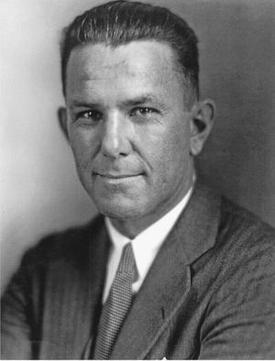
Lewis Woolford Hardage was an American college football player and college football and baseball coach.

Opelika High School is located in Opelika, Lee County, Alabama and was originally built in 1972. Opelika High School, of the Opelika City Schools, serves students in grades 9–12. The principal is Kelli Fischer. The school's assistant principals are Courtney Bass, Allison Gregory, Mike Mckee, and Kelvin Philpott.
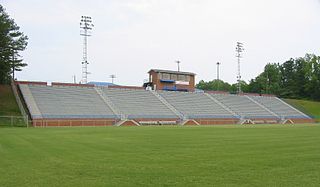
Duck Samford Stadium is a stadium in Auburn, Alabama. It is primarily used for American football and soccer, and is the home field of the Auburn High School Tigers. Duck Samford Stadium was constructed in 1968, and seats 8,310 spectators. The field is named after James Drake "Duck" Samford, a former Auburn University football player and longtime supporter of youth athletics in Auburn who donated the land for the facility.

Harry Walker Hughes was an American football player, coach of football, basketball, baseball, and track, and college athletics administrator. From 1911 to 1941, he served as the head football coach and athletic director at the Agricultural College of Colorado, renamed Colorado A&M in 1935 and now known as Colorado State University, compiling a record of 126–96–18.

John Farrell "Big John" Macklin was an American football player, coach of football, basketball, baseball and track and field, and a college athletics administrator. He served as the head football coach at Michigan Agricultural College, now Michigan State University from 1911 to 1915. With a five-year record of 29–5, he has the highest winning percentage of any football coach in Michigan State history. Macklin coached the Michigan State Spartans football team to its first ever victories over Ohio State, Michigan, Wisconsin, and Penn State. He was also the athletic director at Michigan Agricultural and coached the school's basketball, baseball, and track and field teams. Macklin tallied marks of 48–38 as head basketball coach (1910–1916) and 52–27 as head baseball coach (1911–1915).
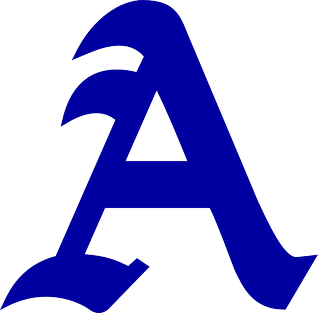
The Auburn High School Tigers are the athletic teams which represent Auburn High School in Auburn, Alabama. Auburn High School's athletics program fields twenty-one varsity teams as a member of the large-school classification (7A) of the Alabama High School Athletic Association. The Tigers' school colors are royal blue and white and the school's mascot is a tiger named Samford.
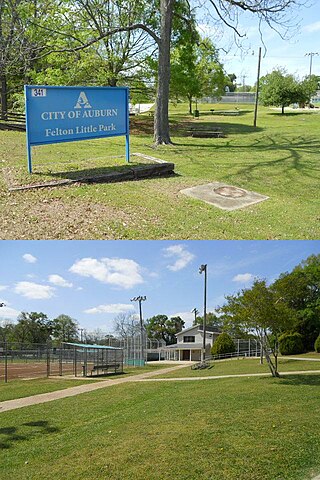
Felton Little Park is a municipal park in Auburn, Alabama, United States. Felton Little Park is the oldest park in Auburn. From 1949 until 1968, the park was the home stadium of the Auburn High School Tigers football team, and from 1949 through 1967, the Auburn High School baseball team. Today, Felton Little Park has three softball fields for youth leagues. The park is named for Felton Little, an Auburn city councilman who donated the land for the park.
Ross Field was an American football and baseball field located in Auburn, Alabama, United States from 1921 until 1998. It was the home field of the Auburn High School Tigers football team from 1921 until 1935. Ross Field was named for Bennett Battle Ross, Jr., an Auburn High School alumnus who was Dean of Chemistry and acting president of the Alabama Polytechnic Institute who had worked to bring county flagship status to Auburn High in 1914. Ross Field was the first on-campus stadium for Auburn High School; previous football teams had shared Drake Field with the Auburn University football team. From 1929 onward, the field was sometimes known as Mitchell Field.

Richard Joseph "Moon" "Duke" DuCôté was an American baseball, football, and basketball coach, football and baseball player, football official, and businessman. He first attended Spring Hill College and was a notable athlete at Auburn University. He played minor league baseball with the Mobile Bears, Portsmouth Truckers, and Charlotte Hornets. In 1920, he played with the Cleveland Tigers of the American Professional Football Association.

The 1949 Auburn Tigers football team represented Auburn University in the 1949 college football season. It was the Tigers' 58th overall and 17th season as a member of the Southeastern Conference (SEC). The team was led by head coach Earl Brown, in his second year, and played their home games at Cliff Hare Stadium in Auburn, the Cramton Bowl in Montgomery and Ladd Memorial Stadium in Mobile, Alabama. They finished the season with a record of two wins, four losses and three ties.
